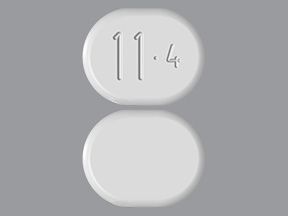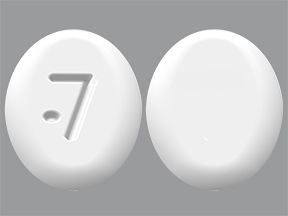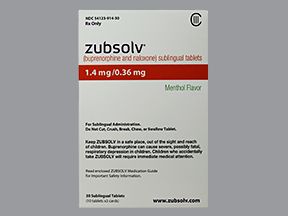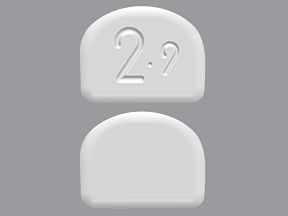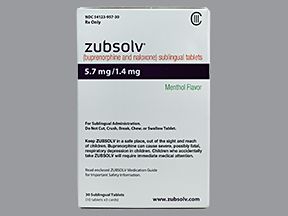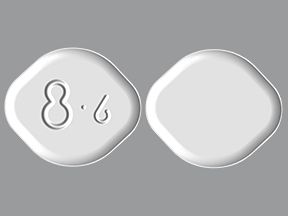Zubsolv (buprenorphine/naloxone) is a brand-name drug that’s prescribed for opioid use disorder. Zubsolv comes as a tablet that dissolves under your tongue. After your starting dosage, Zubsolv is typically taken once per day.
Zubsolv is used to treat opioid use disorder along with a treatment plan that includes counseling and other forms of mental health support.
Zubsolv belongs to a drug class called partial opioid agonists. It’s not available in a generic version.
Keep reading for specific information about the dosage of Zubsolv, including its strengths and how to take the medication. For a comprehensive look at Zubsolv, see this article.
Note: This article describes typical dosages for Zubsolv provided by the drug’s manufacturer. When taking Zubsolv, always follow the dosage prescribed by your doctor.
Zubsolv is used to treat opioid use disorder in combination with counseling and other forms of mental health support. Below is information on typical dosages used for this condition.
Zubsolv form
Zubsolv comes as sublingual tablets, which dissolve under your tongue.
Zubsolv strengths
Zubsolv tablets are available in six strengths:
- 0.7 milligrams (mg) buprenorphine/0.18 mg naloxone
- 1.4 mg buprenorphine/0.36 mg naloxone
- 2.9 mg buprenorphine/0.71 mg naloxone
- 5.7 mg buprenorphine/1.4 mg naloxone
- 8.6 mg buprenorphine/2.1 mg naloxone
- 11.4 mg buprenorphine/2.9 mg naloxone
Typical dosages
Typically, your doctor will start by prescribing a low dosage. Then they’ll adjust it over time to reach the amount that’s right for you. Your doctor will ultimately prescribe the smallest dosage that provides the desired effect.
The following information describes dosages that are commonly used or recommended. But be sure to take the dosage your doctor prescribes for you. They’ll determine the best dosage to fit your needs.
Zubsolv is typically prescribed to be taken in two phases: the induction (starting) phase and the maintenance (long-term) phase. The usual dosage of Zubsolv for each phase is described in more detail below.
Induction phase
Treatment with Zubsolv typically begins at least 6 hours after your last dose of opioid drugs. This is to help prevent severe opioid withdrawal symptoms.* However, it’s possible to experience mild withdrawal symptoms before you start taking Zubsolv. Your doctor will ultimately determine the best time for you to start treatment.
The induction phase typically lasts 2 days. During this time, you’ll likely take your Zubsolv doses in a doctor’s office or clinic. This lets your healthcare professional monitor you after taking the drug so that they can treat any side effects you have.
Your Zubsolv induction dosage is based on the type of opioid you’ve used in the past:
- Short-acting opioid. If you’ve used a short-acting opioid in the past, your induction dosage may be as follows:
- day 1: up to 5.7 mg buprenorphine/1.4 mg naloxone, taken as one to four doses throughout the day
- day 2: up to 11.4 mg buprenorphine/2.9 mg naloxone, taken as one dose
- Long-acting opioid. If you’ve used a long-acting opioid in the past, your doctor will likely prescribe a drug other than Zubsolv during your induction phase. Zubsolv contains the active drugs buprenorphine and naloxone. Instead of Zubsolv, you’ll typically be given a drug that contains buprenorphine without naloxone. This is because taking naloxone while long-acting opioids are still present in your body can cause opioid withdrawal symptoms.*
The below chart includes some examples of these types of opioid drugs.
| Short-acting opioids | Long-acting opioids |
| • heroin • immediate-release† forms of: hydrocodone, hydromorphone (Dilaudid), morphine, and oxycodone | • fentanyl (Actiq) • extended-release‡ forms of: hydromorphone, morphine (MS Contin, Kadian), oxycodone, and oxymorphone |
After this induction phase, you’ll move on to the maintenance phase of Zubsolv treatment.
* Withdrawal causes unpleasant symptoms when you stop taking a drug that your body has become dependent upon. For more information, see the “Zubsolv and withdrawal and dependence” section below.
† Immediate-release means that the drug is released into your body all at once.
‡ Extended-release means that the drug is released into your body slowly, over time.
Maintenance phase
The maintenance phase typically begins on day 3 of treatment. The dosage you’re first prescribed in the maintenance phase will likely be different from the dosage you’ll take long term. This is because your doctor will adjust your treatment until you reach your target dosage. Your target dosage is the lowest dosage of the drug that’s effective for preventing withdrawal without causing bothersome side effects.
Depending on how Zubsolv affects you, your individual target dosage may be lower or higher than the typical dosage recommended by the drug’s manufacturer. An example of a target dosage chart for the Zubsolv maintenance phase is shown below. The strengths shown below are for buprenorphine and naloxone (Zubsolv’s active drugs).
| Typical daily dosage range | Recommended daily target dosage | |
| Maintenance phase | 2.9 mg/0.71 mg to 17.2 mg/4.2 mg | 11.4 mg/2.9 mg, once daily |
In the maintenance phase, your doctor will work with you to decide if you should take your Zubsolv doses in a clinic or at home. Regardless of where you take your doses, you’ll continue to see your doctor regularly during your treatment. You may have daily, weekly, or monthly appointments depending on your individual needs. These regular visits with your doctor will help you meet your goals for treatment.
Long-term use
Zubsolv is meant to be used as a long-term treatment. If you and your doctor determine that Zubsolv is safe and effective for you, you’ll likely take it long term.
The Zubsolv dosage your doctor prescribes will depend on several factors. These include:
- the severity of your opioid use disorder
- whether you used short-acting or long-acting opioid drugs before starting Zubsolv
- the amount of time that’s passed since you last used opioid drugs
- other medications you’ve taken to treat your opioid use disorder in the past
- other medications you’re currently taking
If you have questions about your prescribed dosage, talk with your doctor.
Zubsolv can cause dependence. Dependence means that your body relies on a medication in order to function as it typically does. As a result, you may experience opioid withdrawal symptoms if you suddenly stop taking Zubsolv. Withdrawal causes unpleasant symptoms when you stop taking a drug that your body has become dependent upon.
Symptoms of Zubsolv withdrawal can include:
- abdominal pain
- feeling hotter or colder than usual
- fever
- runny nose
- sweating
- tremor (shaking)
- vomiting and diarrhea
- watering eyes
Because Zubsolv can cause withdrawal, it’s important that you don’t stop taking the drug without first talking with your doctor.
If your doctor says it’s safe for you to stop taking Zubsolv, they’ll lower your dosage slowly over time. This reduces your risk for having withdrawal symptoms after stopping the drug.
If you have withdrawal symptoms during treatment with Zubsolv or after you’ve stopped taking the drug, talk with your doctor. They can recommend ways to relieve these symptoms.
Below are some frequently asked questions about Zubsolv and their answers.
What’s the dosage of Zubsolv vs. Suboxone?
Zubsolv and Suboxone are both approved to treat opioid use disorder. Both medications are used in combination with a treatment plan that includes counseling and other forms of mental health support.
Zubsolv comes as a tablet that dissolves under your tongue. Suboxone comes as a film that dissolves under your tongue or inside your cheek.
Zubsolv and Suboxone contain the same active drugs: buprenorphine and naloxone. But the dosages used for Zubsolv and Suboxone are different. This is because the drugs come in different strengths. Below is a chart that shows equivalent doses of each drug. The strengths shown below are for buprenorphine and naloxone and are given in milligrams (mg):
| Zubsolv dose | Equivalent Suboxone dose |
| 1.4 mg/0.36 mg | 2 mg/0.5 mg |
| 2.9 mg/0.71 mg | 4 mg/1 mg |
| 5.7 mg/1.4 mg | 8 mg/2 mg |
| 8.6 mg/2.1 mg | 12 mg/3 mg |
| 11.4 mg/2.9 mg | 16 mg/4 mg |
If your doctor says it’s safe to do so, you may be able to switch from Zubsolv to Suboxone or vice versa. But it’s important to note that you should only take the drug and dosage that your doctor prescribes for you.
If you have questions about how Zubsolv and Suboxone compare, talk with your doctor.
Can I take Zubsolv with food?
You shouldn’t eat or drink while Zubsolv is dissolving under your tongue. But it’s OK to eat or drink right before your dose or after your dose completely dissolves. In fact, it’s recommended that you take a sip of water, gently swish it around your mouth, and swallow after your Zubsolv dose has dissolved. Just be sure to let your dose dissolve entirely first, which can take several minutes.
If you have questions about whether you can eat before or after your Zubsolv dose, talk with your doctor.
Zubsolv comes as a sublingual tablet, which is a tablet that dissolves under your tongue. After you place Zubsolv under your tongue, you should let the tablet fully dissolve. This can take several minutes.
After the tablet has completely dissolved, take a sip of water, swish it gently around your teeth and gums, and swallow. You should not eat or drink anything until the tablet has completely dissolved. You should also wait at least 1 hour after the tablet dissolves to brush your teeth.
If you take more than one Zubsolv tablet for each dose, you can place all of the tablets under your tongue at the same time. If you do this, you should place the tablets in different areas under your tongue. Or you can take one tablet at a time.
You should not chew Zubsolv tablets or swallow them whole. The drug won’t be as effective as usual if the tablet doesn’t fully dissolve under your tongue.
For more detailed information about how to take Zubsolv, visit the manufacturer’s website.
Note: It’s important to practice good dental hygiene while taking Zubsolv. This includes brushing your teeth and flossing regularly. You should also get regular dental checkups, as recommended by your doctor or dentist. Zubsolv can cause teeth problems, so taking care of your teeth and mouth can help reduce this risk.
It’s important that you don’t miss a dose of Zubsolv. This is because having steady levels of the drug in your body helps prevent symptoms of opioid withdrawal. Withdrawal causes unpleasant symptoms when you stop taking a drug that your body has become dependent upon. (See “Zubsolv and withdrawal and dependence” above for examples of Zubsolv withdrawal symptoms.)
If you do miss a Zubsolv dose, take your missed dose as soon as you remember. But if it’s almost time to take your next dose, you can just skip the missed dose and take your next dose at its regular time. You shouldn’t take two doses of Zubsolv to make up for any missed doses. This could raise your risk for side effects from the drug.
To help make sure that you don’t miss a dose, try using a medication reminder. This can include setting an alarm or putting a note where you’ll see it, such as on your bathroom mirror or bedside table. You could also download a reminder app on your phone.
Buprenorphine, one of the active drugs in Zubsolv, is a controlled substance. This means that there’s potential for the drug to be misused. Misuse means taking a drug differently than how it was prescribed. With Zubsolv, this can include snorting crushed tablets or dissolving and injecting the drug. Do not take Zubsolv in these ways. Doing so can lead to dangerous side effects, including withdrawal.
Because of its risk of misuse, Zubsolv is prescribed only by healthcare professionals who’ve received special training. Your doctor will work with you to decide whether you should take your Zubsolv doses in a clinic or at home. Taking your doses in a doctor’s office or clinic can help lessen your risk for misusing the drug. This is because you’ll be supervised by a healthcare professional for each dose. But over time, as you continue opioid use disorder treatment, you may be able to more safely take the drug at home.
If you have concerns about how to use Zubsolv safely, talk with your doctor. They can help you manage your risk for misusing the drug.
If you take more Zubsolv than your doctor prescribes, you may develop serious side effects.
It’s important that you do not take more Zubsolv than your doctor advises.
Symptoms of an overdose
Overdose symptoms of Zubsolv can include:
- low blood pressure
- pinpoint pupils (a condition in which your pupils shrink to a smaller size than usual)
- respiratory depression (shallow, slowed breathing)
- sedation (feeling extremely tired and less alert than usual)
- death
If you take more than the recommended amount of Zubsolv
Call your doctor right away if you believe you’ve taken too much Zubsolv. Another option is to call America’s Poison Centers at 800-222-1222 or use its online tool. If you have severe symptoms, immediately call 911 (or your local emergency number) or go to the nearest emergency room.
The dosages in this article are typical dosages provided by the drug’s manufacturer. If your doctor recommends Zubsolv for you, they’ll prescribe the dosage that’s right for you. Always follow the dosage that your doctor prescribes for you.
As with any drug, never change your dosage of Zubsolv without your doctor’s approval. If you have questions about the dosage of Zubsolv that’s right for you, talk with your doctor.
Besides learning about dosage, you may want other information about Zubsolv. These additional articles might be helpful:
- More about Zubsolv. For information about other aspects of Zubsolv, refer to this article.
- Side effects. To learn about side effects of Zubsolv, see this article. You can also look at the Zubsolv prescribing information.
Disclaimer: Medical News Today has made every effort to make certain that all information is factually correct, comprehensive, and up to date. However, this article should not be used as a substitute for the knowledge and expertise of a licensed healthcare professional. You should always consult your doctor or another healthcare professional before taking any medication. The drug information contained herein is subject to change and is not intended to cover all possible uses, directions, precautions, warnings, drug interactions, allergic reactions, or adverse effects. The absence of warnings or other information for a given drug does not indicate that the drug or drug combination is safe, effective, or appropriate for all patients or all specific uses.

